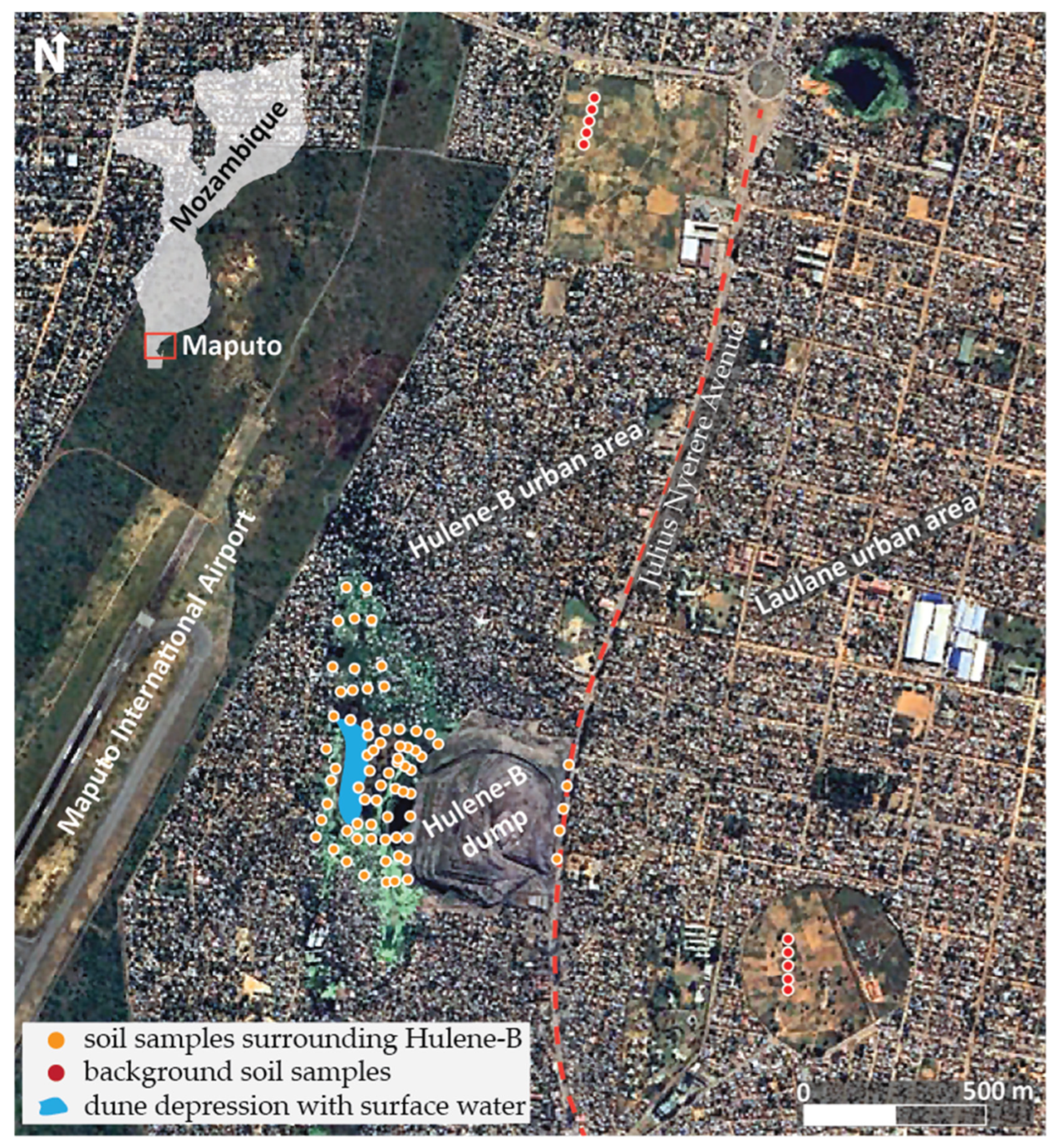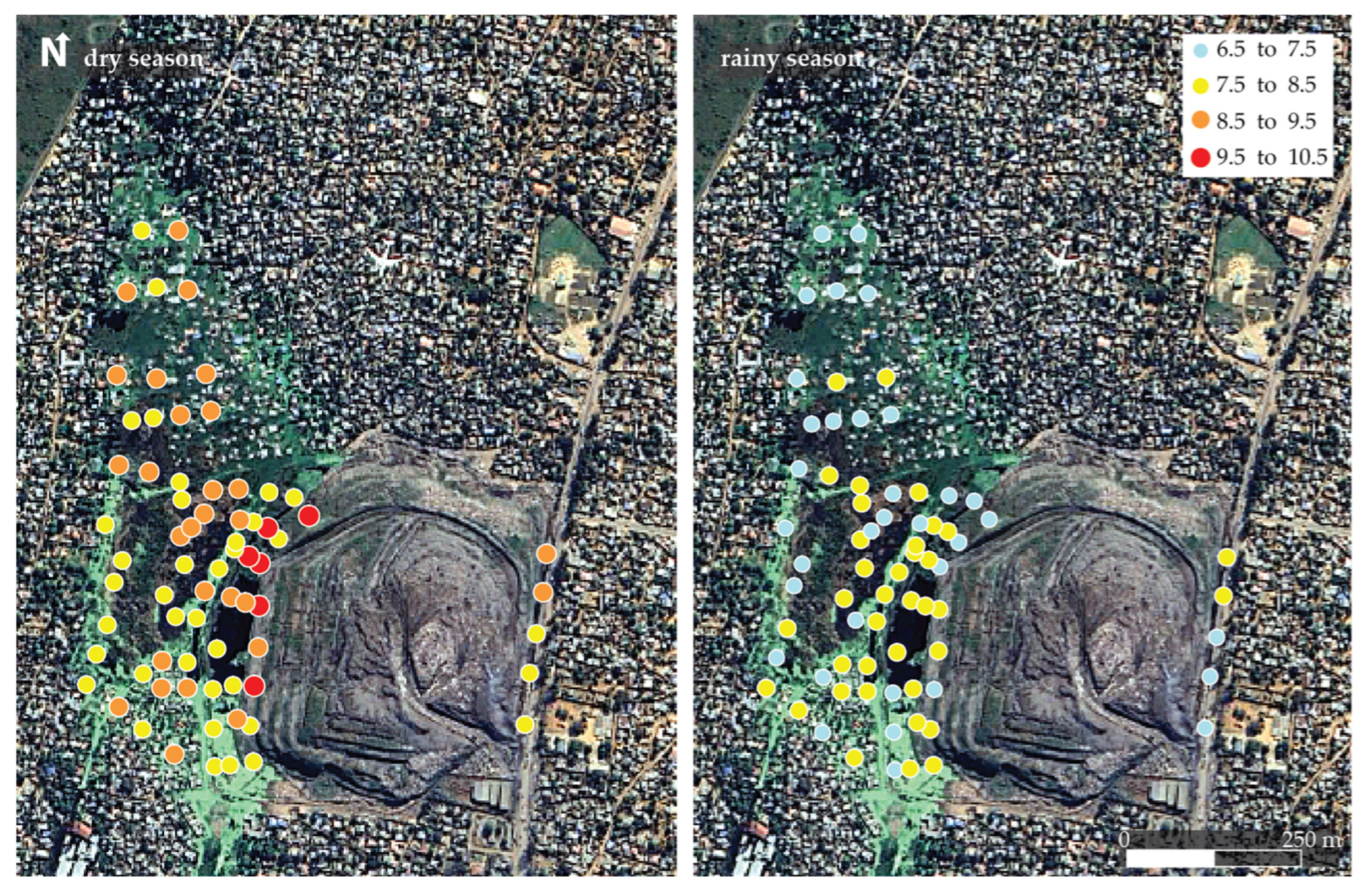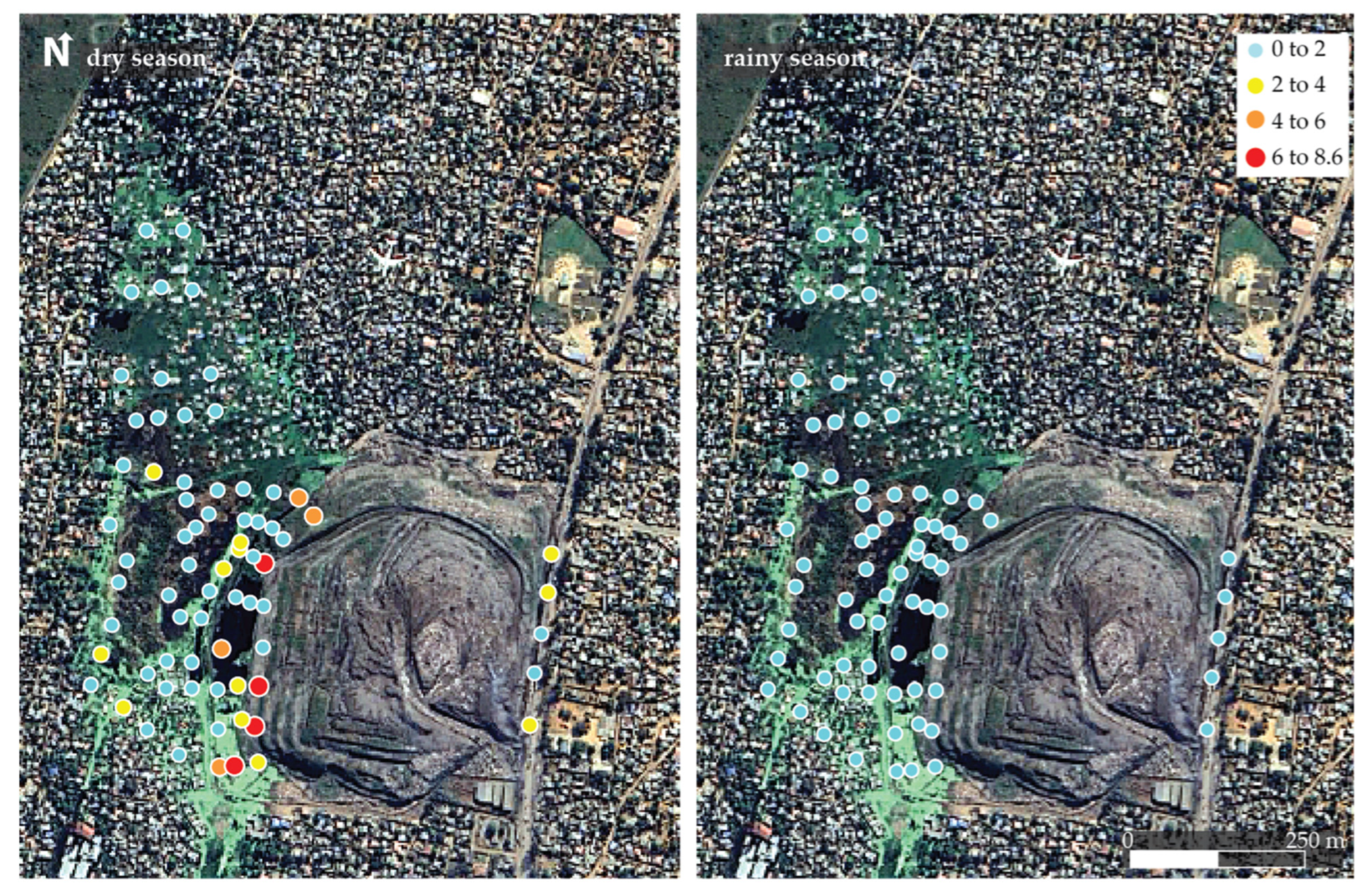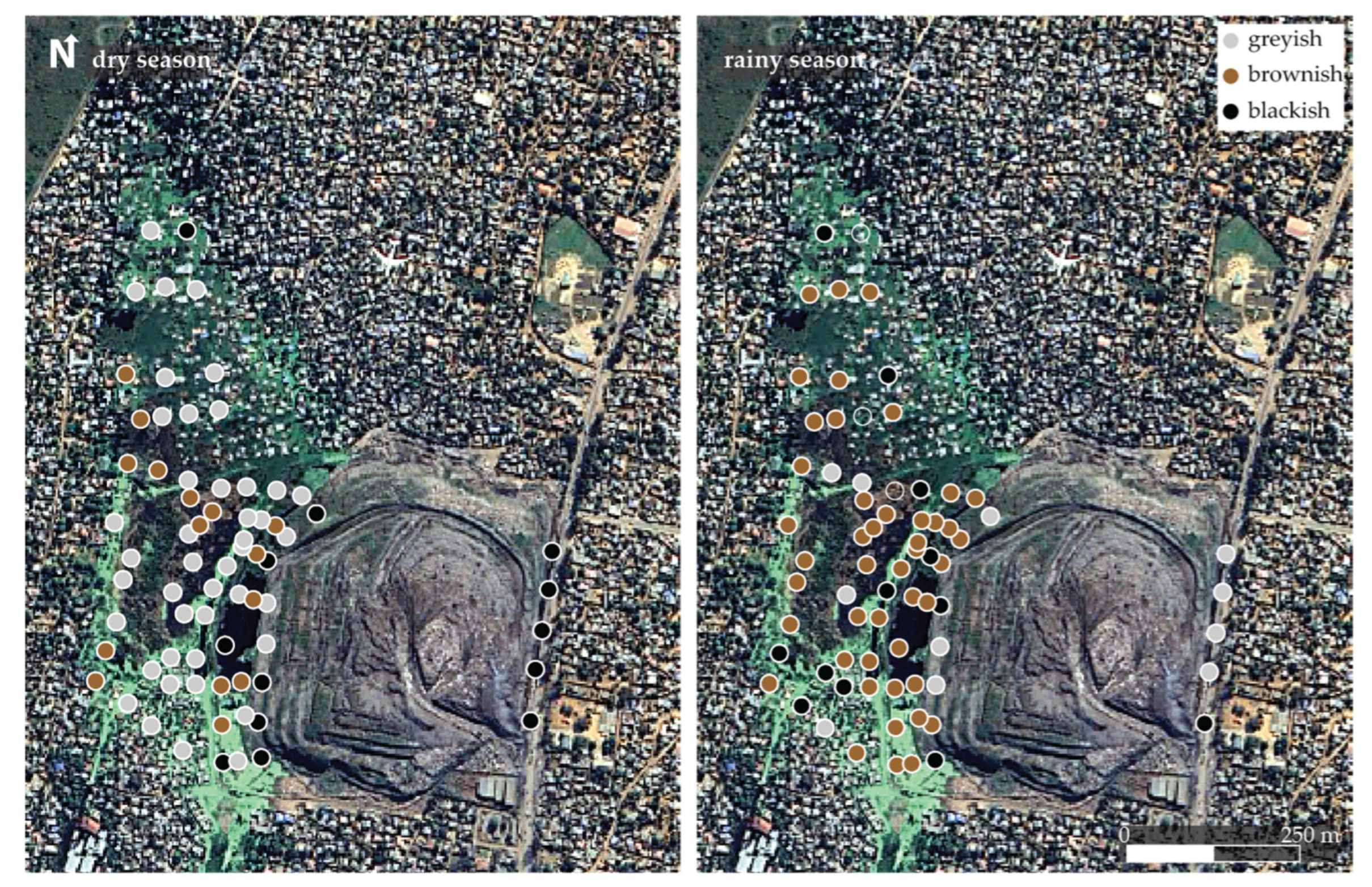Seasonal Dynamics and Leachate-Induced Alteration of Soils and Associated Risk of Surface Water Contamination Around the Hulene-B Waste Dump, Maputo, Mozambique
Abstract
1. Introduction
2. Materials and Methods
2.1. Study Area
2.2. Sampling
2.3. Samples Analysis
2.4. Chemical Alteration Indices
2.4.1. Chemical Index of Alteration (CIA)
2.4.2. Chemical Index of Weathering (CIW)
2.4.3. Plagioclase Index of Alteration (PIA)
2.4.4. Weathering Index of Parker (WIP)
2.4.5. Data Treatment
2.5. Statistical Analysis
2.6. Surface Water Contamination Risk by Landfill
3. Results and Discussion
- Chemical alteration indices
- The A–CN–K diagram
- Potentially toxic elements
- Risk of surface water contamination (Pbci)
4. Conclusions
Supplementary Materials
Author Contributions
Funding
Data Availability Statement
Conflicts of Interest
References
- Souza, V.; Hollas, C.; Bortoli, M.; Manosso, F.; Souza, D. Heavy metal contamination in soils of a decommissioned landfill in southern Brazil: Ecological and health risk assessment. Chemosphere 2023, 339, 139689. [Google Scholar] [CrossRef]
- Audu, P.; Wuana, R. Evaluating the Levels and Human Health Risks of Heavy Metals in Soils around Onne Landfill, Rivers State, Nigeria. Int. Res. J. Pure Apl. Chem. 2021, 22, 43–59. [Google Scholar] [CrossRef]
- Dixit, A.; Singh, D.; Shukla, S. Assessment of human health risk due to leachate contaminated soil at solid waste dumpsite, Kanpur (India). Int. J. Environ. Sci. Technol. 2024, 21, 909–924. [Google Scholar] [CrossRef]
- Toha, M.; Sikder, S.; Rahman, M. An Overview of Existing Municipal Landfill Leachate Treatment Techniques: Opportunities and Challenges. In Landfill Leachate Treatment Techniques; Souabi, S., Anouzla, A., Eds.; Springer Water: Cham, Switzerland, 2024. [Google Scholar] [CrossRef]
- Zaki, K.; Karhat, Y.; Falaki, K. Temporal Monitoring and Effect of Precipitation on the Quality of Leachate from the Greater Casablanca Landfill in Morocco. Pollution 2022, 8, 407–433. [Google Scholar] [CrossRef]
- Ibrahim, T.; Mahmood, N.; Othman, F. Estimation of leachate generation from MSW landfills in Selangor. Asian J. Microbiol. Biotech. Environ. Sci. 2017, 19, 43–48. [Google Scholar]
- Wijekoon, P.; Koliyabandara, P.; Cooray, A.; Lam, S.; Athapattu, B.; Vithanage, M. Progress and prospects in mitigation of landfill leachate pollution: Risk, pollution potential, treatment and challenges. J. Hazard. Mater. 2022, 421, 126627. [Google Scholar] [CrossRef] [PubMed]
- Yang, Z.; Lin, S.; Ye, L.; Qu, D.; Yang, H.; Chang, H.; Yu, H.; Yan, Z.; Rong, H.; Qu, F. Landfill leachate treatment by direct contact membrane distillation: Impacts of landfill age on contaminant removal performance, membrane fouling and scaling. Desalination 2024, 577, 117407. [Google Scholar] [CrossRef]
- Siddiqi, S.; Al-Mamun, A.; Sana, A.; Baawain, M.; Choudhury, M. Characterization and pollution potential of leachate from urban landfills during dry and wet periods in arid regions. Water Supply 2022, 22, 3462–3483. [Google Scholar] [CrossRef]
- Udoh, U.; Babatunde, O.; Ibrahim, I.; Fidelis, G.; Eke, C. The Assessment of Heavy Metal Contamination and Ecological Risks in Soils Surrounding Dumpsites in Ikwuano LGA, Abia State. Int. J. Adv. Biol. Biomed. Res. 2025, 13, 405–425. [Google Scholar] [CrossRef]
- Yuan, W.; Balajiang, G.; Dang, Y.; Xie, J.; Zhao, W.; Cong, Y.; Ai, S. Spatial distribution, pollution assessment and source identification of heavy metals in Yarlung Zangbo River, Tibet. Process Saf. Environ. Prot. 2025, 202, 107768. [Google Scholar] [CrossRef]
- Ouhakki, H.; Hmouni, D.; El Fallah, K.; El Mejdoub, N.; Adiba, A. Groundwater quality dynamics in Doukkala, Morocco—Exploring seasonal and temporal variations in physicochemical and bacteriological traits. J. Ecol. Eng. 2025, 26, 95–108. [Google Scholar] [CrossRef] [PubMed]
- Pagnanelli, F.; Esposito, A.; Toro, L. Metal speciation and pH effect on Pb, Cu, Zn and Cd biosorption onto Sphaerotilus natans: Langmuir-type empirical model. Water Res. 2003, 37, 627–633. [Google Scholar] [CrossRef] [PubMed]
- Ghobadi, R.; Altaee, A.; Zhou, J.; Karbassiyazdi, E.; Ganbat, N. Effective remediation of heavy metals in contaminated soil by electrokinetic technology incorporating reactive filter media. J. Sci. Total Environ. 2021, 794, 148668. [Google Scholar] [CrossRef] [PubMed]
- Dagwar, P.; Dutta, D. Landfill leachate a potential challenge towards sustainable environmental management. Sci. Total Environ. 2024, 926, 171668. [Google Scholar] [CrossRef]
- Sun, R.; Gao, Y.; Yang, Y. Leaching of heavy metals from lead-zinc mine tailings and the subsequent migration and transformation characteristics in paddy soil. Chemosphere 2022, 291, 132792. [Google Scholar] [CrossRef]
- Hoya, A.; Kamelia, M.; Sari, I. Analysis of the amount of leachate pollution on the environmental health of settlements at Bakung final disposal site Bandar Lampung City. J. Eduhealth 2023, 14, 707–712. Available online: https://ejournal.seaninstitute.or.id/index.php/healt/article/view/2092 (accessed on 3 February 2025).
- Rapti-Caputo, A.; Sdao, F.; Masi, S. Pollution risk assessment based on hydrogeological data and management of solid waste landfills. Eng. Geol. 2006, 85, 122–131. [Google Scholar] [CrossRef]
- Calvo, F.; Moreno, B.; Zamorano, M.; Szanto, M. Environmental diagnosis methodology for municipal waste landfills. Waste Manag. 2005, 25, 768–779. [Google Scholar] [CrossRef]
- Serra, C. Da Problemática Ambiental à Mudança: Rumo à um Mundo Melhor; Escolar Editora, Ed.; Universidade Católica de Moçambique (UCM): Maputo, Mozambique, 2012. (In Portuguese) [Google Scholar]
- CMCM Quadro da Política de Reassentamento—QPR Novembro de 2020. Conselho Municipal da Cidade de Maputo, 2020. Available online: https://documents1.worldbank.org/curated/en/964181607106676324/pdf/Revised-Resettlement-Framework-Maputo-Urban-Transformation-Project-P171449.pdf (accessed on 10 October 2022).
- Vicente, E.; Jermy, C.; Schreiner, H. Urban geology of Maputo, Mozambique. Eng. Geol. Tomorrow’s Cities Geol. Soc. Lond. Eng. Geol. Spec. Publ. 2006, 338, 1–13. [Google Scholar]
- Bernardo, B.; Candeias, C.; Rocha, F. Integration of Electrical Resistivity and Modified DRASTIC Model to Assess Groundwater Vulnerability in the Surrounding. Water 2022, 14, 1746. [Google Scholar] [CrossRef]
- Bernardo, B.; Candeias, C.; Rocha, F. Application of Geophysics in geo-environmental diagnosis on the surroundings of the Hulene-B waste dump, Maputo, Mozambique. J. Afr. Earth Sci. 2022, 185, 104415. [Google Scholar] [CrossRef]
- Bernardo, B.; Candeias, C.; Rocha, F. Soil properties and environmental risk assessment of soils in the surrounding area of Hulene-B waste dump, Maputo (Mozambique). Environ. Earth Sci. 2022, 81, 542. [Google Scholar] [CrossRef]
- Bernardo, B.; Candeias, C.; Rocha, F. Characterization of the Dynamics of Leachate Contamination Plumes in the Surroundings of the Hulene-B Waste Dump in Maputo, Mozambique. Environments 2022, 9, 19. [Google Scholar] [CrossRef]
- Bernardo, B.; Candeias, C.; Rocha, F. Soil Risk Assessment in the Surrounding Area of Hulene-B Waste Dump, Maputo (Mozambique). Geosciences 2022, 12, 290. [Google Scholar] [CrossRef]
- Bernardo, B.; Candeias, C.; Rocha, F. The Contribution of the Hulene-B Waste Dump (Maputo, Mozambique) to the Contamination of Rhizosphere Soils, Edible Plants, Stream Waters, and Groundwaters. Environments 2023, 10, 45. [Google Scholar] [CrossRef]
- Hoai, S.; Lan, H.; Viet, N.; Hoang, G.; Kawamoto, K. Characterizing seasonal variation in landfill leachate using leachate pollution index (LPI) at nam son solid waste landfill in Hanoi, Vietnam. Environments 2021, 8, 17. [Google Scholar] [CrossRef]
- Ozbay, G.; Jones, M.; Gadde, M.; Isah, S.; Attarwala, T. Design and operation of effective landfills with minimal effects on the environment and human health. J. Environ. Public Health 2021, 2021, 6921607. [Google Scholar] [CrossRef]
- INE Boletim de Estatísticas Demográficas e Sociais, Maputo Cidade 2019. Instituto Nacional de Estatistica, 2020. Available online: https://www.ine.gov.mz/ (accessed on 22 October 2022).
- Ferrão, D. Evaluation of Removal and Disposal of Solid Waste in Maputo City, Mozambique. Ph.D. Dissertation, University of Cape Town, Cape Town, South Africa, 2006. [Google Scholar]
- Muchangos, L.; Tokai, A.; Hanashima, A. Analyzing the structure of barriers to municipal solid waste management policy planning in Maputo city, Mozambique. Environ. Dev. 2015, 16, 76–89. [Google Scholar] [CrossRef]
- Cendón, D.I.; Haldorsen, S.; Chen, J.; Hankin, S.; Nogueira, G.; Momade, F.; Achimo, M.; Muiuane, E.; Mugabe, J.; Stigter, T. Hydrogeochemical aquifer characterization and its implication for groundwater development in the Maputo district, Mozambique. Quat. Int. 2020, 547, 113–126. [Google Scholar] [CrossRef]
- Momade, F.; Ferrara, M.; Oliveira, J. Notícia Explicativa da Carta Geológica 2532 Maputo (Escala 1:50000); Direcção Nacional de Geologia (DNG), Ministério dos Recursos Minerais e Energia: Maputo, Mozambique, 1996. (In Portuguese) [Google Scholar]
- Muchimbane, A. Estudo dos Indicadores da Contaminação das Aguas Subterrâneas por Sistemas de Saneamento in Situ—Distrito Urbano 4. Ph.D. Dissertation, São Paulo University, Cidade de Maputo, Moçambique, 2010. [Google Scholar]
- Nogueira, G.; Stigter, T.; Zhou, Y.; Mussa, F.; Juizo, D. Understanding groundwater salinization mechanisms to secure freshwater resources in the water-scarce city of Maputo, Mozambique. Sci. Total Environ. 2019, 661, 723–736. [Google Scholar] [CrossRef]
- CIAT. Climate-Smart Agriculture in Mozambique. Center for Tropical Agriculture, 2017. Available online: https://climateknowledgeportal.worldbank.org/sites/default/files/2019-06/CSA-in-Mozambique.pdf (accessed on 8 October 2022).
- Reeuwijk, L. Procedures for Soil Analysis; International Soil Reference and Information Centre: Wageningen, The Netherlands, 2002. [Google Scholar]
- Munsell Soil Color Charts: With Genuine Munsell Color Chips; Munsell Color, X-Rite, Inc.: Grand Rapids, MI, USA, 2009.
- Candeias, C.; Santos, I.; Rocha, F. Characterization and Suitability for Ceramics Production of Clays from Bustos, Portugal. Minerals 2025, 15, 503. [Google Scholar] [CrossRef]
- Biscaye, P. Mineralogy and Sedimentation of Recent Deep-Sea Clay in the Atlantic Ocean and Adjacent Seas and Oceans. GSA Bull. 1965, 76, 803–832. [Google Scholar] [CrossRef]
- Nesbitt, H.; Young, G. Early Proterozoic climates and plate motions inferred from major element chemistry of lutites. Nature 1982, 299, 15–717. [Google Scholar] [CrossRef]
- Fedo, C.; Nesbitt, H.; Young, G. Unraveling the effects of potassium metasomatism in sedimentary rocks and paleosols, with implications for paleoweathering conditions and provenance. Geology 1995, 23, 921–924. [Google Scholar] [CrossRef]
- Harnois, L. The CIW index: A new chemical index of weathering. Sediment. Geol. 1988, 55, 319–322. [Google Scholar] [CrossRef]
- Parker, A. An Index of Weathering for Silicate Rocks. Geol. Mag. 1970, 107, 501–504. [Google Scholar] [CrossRef]
- Nesbitt, H.; Young, G. Prediction of some weathering trends of plutonic and volcanic rocks based on thermodynamic and kinetic considerations. Geochim. Cosmochim. Acta 1984, 48, 1523–1534. [Google Scholar] [CrossRef]
- Groth, D.; Hartmann, S.; Klie, S.; Selbig, J. Principal Components Analysis. In Computational Toxicology. Methods in Molecular Biology; Reisfeld, B., Mayeno, A., Eds.; Humana Press: Totowa, NJ, USA, 2012; Volume 930. [Google Scholar] [CrossRef]
- Aryampa, S.; Maheshwari, B.; Sabiiti, E.; Olobo, C.; Bateganya, N. Adaptation of EVIAVE methodology to landfill environmental impact assessment in Uganda—A case study of Kiteezi landfill. J. Afr. Earth Sci. 2021, 183, 104310. [Google Scholar] [CrossRef]
- Rieuwerts, J.; Ashmore, M.; Farago, M.; Thornton, I. The influence of soil characteristics on the extractability of Cd, Pb and Zn in upland and moorland soils. Sci. Total Environ. 2006, 366, 864–875. [Google Scholar] [CrossRef]
- Alleoni, L.; Iglesias, C.; Mello, S.; Camargo, O.; Casagrande, J.; Lavorenti, N. Soil attributes related to cadmium and copper adsorption in tropical soils. Acta Sci. Agron. 2005, 27, 729–737. [Google Scholar] [CrossRef]
- Naveen, B.; Mahapatra, D.; Sitharam, T.; Sivapullaiah, P.; Ramachandra, T. Physico-chemical and biological characterization of urban municipal landfill leachate. Environ. Pollut. 2017, 220, 1–12. [Google Scholar] [CrossRef] [PubMed]
- Škrbić, B.; Čupić, S. Trace Metal Distribution in Surface Soils of Novi Sad and Bank Sediment of the Danube River. J. Environ. Sci. Health 2004, 39, 1547–1558. [Google Scholar] [CrossRef] [PubMed]
- Ashraf, M.; Zeshan, M.; Hafeez, S.; Hussain, R.; Qadir, A.; Majid, M.; Ahmad, S. Temporal variation in leachate composition of a newly constructed landfill site in Lahore in context to environmental pollution and risks. Environ. Sci. Pollut. Res. 2022, 29, 37129–37143. [Google Scholar] [CrossRef] [PubMed]
- Azeez, J.; Hassan, O.; Egunjobi, P. Soil contamination at dumpsites: Implication of soil heavy metals distribution in municipal solid waste disposal system: A case study of Abeokuta, southwestern Nigeria. Soil Sediment Contam. 2011, 20, 370–386. [Google Scholar] [CrossRef]
- Wu, G.; Wang, L.; Yang, R.; Hou, W.; Zhang, S.; Guo, X.; Zhao, W. Pollution characteristics and risk assessment of heavy metals in the soil of a construction waste landfill site. Ecol. Inform. 2022, 70, 101700. [Google Scholar] [CrossRef]
- Carmo, D.; Lima, L.; Silva, C. Soil Fertility and Electrical Conductivity Affected by Organic Waste Rates and Nutrient Input. Soil. Use Manag. 2016, 40, e0150152. [Google Scholar] [CrossRef]
- Nisari, A.; Sujatha, C. Assessment of trace metal contamination in the Kol wetland, a Ramsar site, Southwest coast of India. Reg. Stud. Mar. Sci. 2021, 47, 101953. [Google Scholar] [CrossRef]
- Kanmani, S.; Gandhimathi, R. Assessment of heavy metal contamination in soil due to leachate migration from an open dumping site. Appl. Water Sci. 2013, 3, 193–205. [Google Scholar] [CrossRef]
- Hussein, M.; Yoneda, K.; Mohd-Zaki, Z.; Amir, A.; Othman, N. Heavy metals in leachate, impacted soils and natural soils of different landfills in Malaysia: An alarming threat. Chemosphere 2021, 267, 128874. [Google Scholar] [CrossRef]
- Tao, Z.; Deng, H.; Li, M.; Chai, X. Mercury transport and fate in municipal solid waste landfills and its implications. Biogeochemistry 2020, 148, 19–29. [Google Scholar] [CrossRef]
- Weibel, G.; Eggenberger, U.; Schlumberger, S.; Mäder, U. Chemical associations and mobilization of heavy metals in fly ash from municipal solid waste incineration. Waste Manag. 2017, 62, 147–159. [Google Scholar] [CrossRef]
- De Paepe, J.; Alvarez, R. Development of a Regional Soil Productivity Index Using an Artificial Neural Network Approach. Agron. J. 2013, 105, 1803–1813. [Google Scholar] [CrossRef]
- Buggle, B.; Glaser, B.; Hambach, U.; Gerasimenko, N.; Marković, S. An evaluation of geochemical weathering indices in loess–paleosol studies. Quat. Int. 2011, 240, 12–21. [Google Scholar] [CrossRef]
- Obasi, R.; Madukwe, H.; Nnabo, P. Geochemistry, weathering intensity and palaeoclimatic conditions of soils around dumpsites from Ibadan, Oyo State, Nigeria. Eur. J. Basic Appl. Sci. 2020, 7, 1–15. [Google Scholar]
- Naveen, B.; Sumalatha, J.; Malik, R. A study on contamination of ground and surface water bodies by leachate leakage from a landfill in Bangalore, India. Int. J. Geo-Eng. 2018, 9, 27. [Google Scholar] [CrossRef]








| Index | Range | Weathering Grade |
|---|---|---|
| CIA/CIW/PIA: | ||
| <50 | Unweathered to weakly altered | No alteration |
| 50–65 | Incipient alteration | Incipient alkali leaching |
| 65–85 | Moderate to advanced alteration | Feldspar to smectite/illite formation |
| 85–100 | Intense weathering or complete feldspar decomposition (kaolinite–gibbsite stage) | Kaolinite/gibbsite stage; mature soil |
| WIP: | ||
| >200 | Fresh rock | Base-cation rich |
| 60–200 | Moderate weathering | Partial cation loss |
| <60 | Strong weathering | Depleted base cations |
| Fraction | Dry Season | Rainy Season | ||||||
|---|---|---|---|---|---|---|---|---|
| Min | Max | Mean | SD | Max | Min | Mean | SD | |
| sand | 81.9 | 97.9 | 93.9 | 3.8 | 90.5 | 99.3 | 97.0 | 1.9 |
| silt | 1.3 | 12.7 | 4.5 | 3.0 | 0.4 | 7.7 | 2.1 | 1.4 |
| clay | 0.6 | 5.4 | 1.6 | 0.9 | 0.2 | 2.6 | 0.9 | 0.5 |
| Variables | Dry Season | Rainy Season | ||||||
|---|---|---|---|---|---|---|---|---|
| Min | Max | Mean | SD | Min | Max | Mean | SD | |
| pH | 4.8 | 6.2 | 5.6 | 0.4 | 4.2 | 6.3 | 5.3 | 0.9 |
| EC | 10.8 | 30.3 | 20.1 | 9.3 | 9.8 | 28.1 | 18.3 | 7.3 |
| OM | 0.4 | 1.2 | 0.8 | 0.2 | 0.3 | 0.6 | 0.5 | 0.1 |
| CIA | CIW | PIA | WIP | |
|---|---|---|---|---|
| min (I) | 2.3 | 2.4 | 1.4 | 0.1 |
| min (II) | 46.8 | 66.6 | 42.1 | 0.1 |
| Q25 (I) | 64.8 | 86.8 | 80.6 | 0.1 |
| Q25 (II) | 64.8 | 84.3 | 78.4 | 0.1 |
| Q50 (I) | 67.1 | 91.1 | 85.8 | 0.1 |
| Q50 (II) | 67.5 | 87.1 | 81.9 | 0.1 |
| Q75 (I) | 68.6 | 93.1 | 89.1 | 0.2 |
| Q75 (II) | 70.3 | 90.4 | 85.9 | 0.2 |
| max (I) | 75.9 | 96.1 | 94.7 | 0.3 |
| max (II) | 83.2 | 94.4 | 93.3 | 0.6 |
| Variables | W*C | |
|---|---|---|
| Compaction | 6 | |
| Daily Cover | 8 | |
| Control of leachate | 8 | |
| Final coverage | 8 | |
| Type of waste and % organic matter | 8 | |
| Waterproofing the discharge point | 8 | |
| Rainfall | 4 | |
| Existence and distance of surface water | 8 | |
| Contamination risk | High | 0.91 |
Disclaimer/Publisher’s Note: The statements, opinions and data contained in all publications are solely those of the individual author(s) and contributor(s) and not of MDPI and/or the editor(s). MDPI and/or the editor(s) disclaim responsibility for any injury to people or property resulting from any ideas, methods, instructions or products referred to in the content. |
© 2025 by the authors. Licensee MDPI, Basel, Switzerland. This article is an open access article distributed under the terms and conditions of the Creative Commons Attribution (CC BY) license (https://creativecommons.org/licenses/by/4.0/).
Share and Cite
Bernardo, B.; Candeias, C.; Rocha, F. Seasonal Dynamics and Leachate-Induced Alteration of Soils and Associated Risk of Surface Water Contamination Around the Hulene-B Waste Dump, Maputo, Mozambique. Appl. Sci. 2025, 15, 11663. https://doi.org/10.3390/app152111663
Bernardo B, Candeias C, Rocha F. Seasonal Dynamics and Leachate-Induced Alteration of Soils and Associated Risk of Surface Water Contamination Around the Hulene-B Waste Dump, Maputo, Mozambique. Applied Sciences. 2025; 15(21):11663. https://doi.org/10.3390/app152111663
Chicago/Turabian StyleBernardo, Bernardino, Carla Candeias, and Fernando Rocha. 2025. "Seasonal Dynamics and Leachate-Induced Alteration of Soils and Associated Risk of Surface Water Contamination Around the Hulene-B Waste Dump, Maputo, Mozambique" Applied Sciences 15, no. 21: 11663. https://doi.org/10.3390/app152111663
APA StyleBernardo, B., Candeias, C., & Rocha, F. (2025). Seasonal Dynamics and Leachate-Induced Alteration of Soils and Associated Risk of Surface Water Contamination Around the Hulene-B Waste Dump, Maputo, Mozambique. Applied Sciences, 15(21), 11663. https://doi.org/10.3390/app152111663








